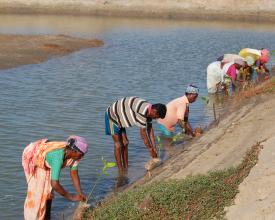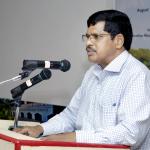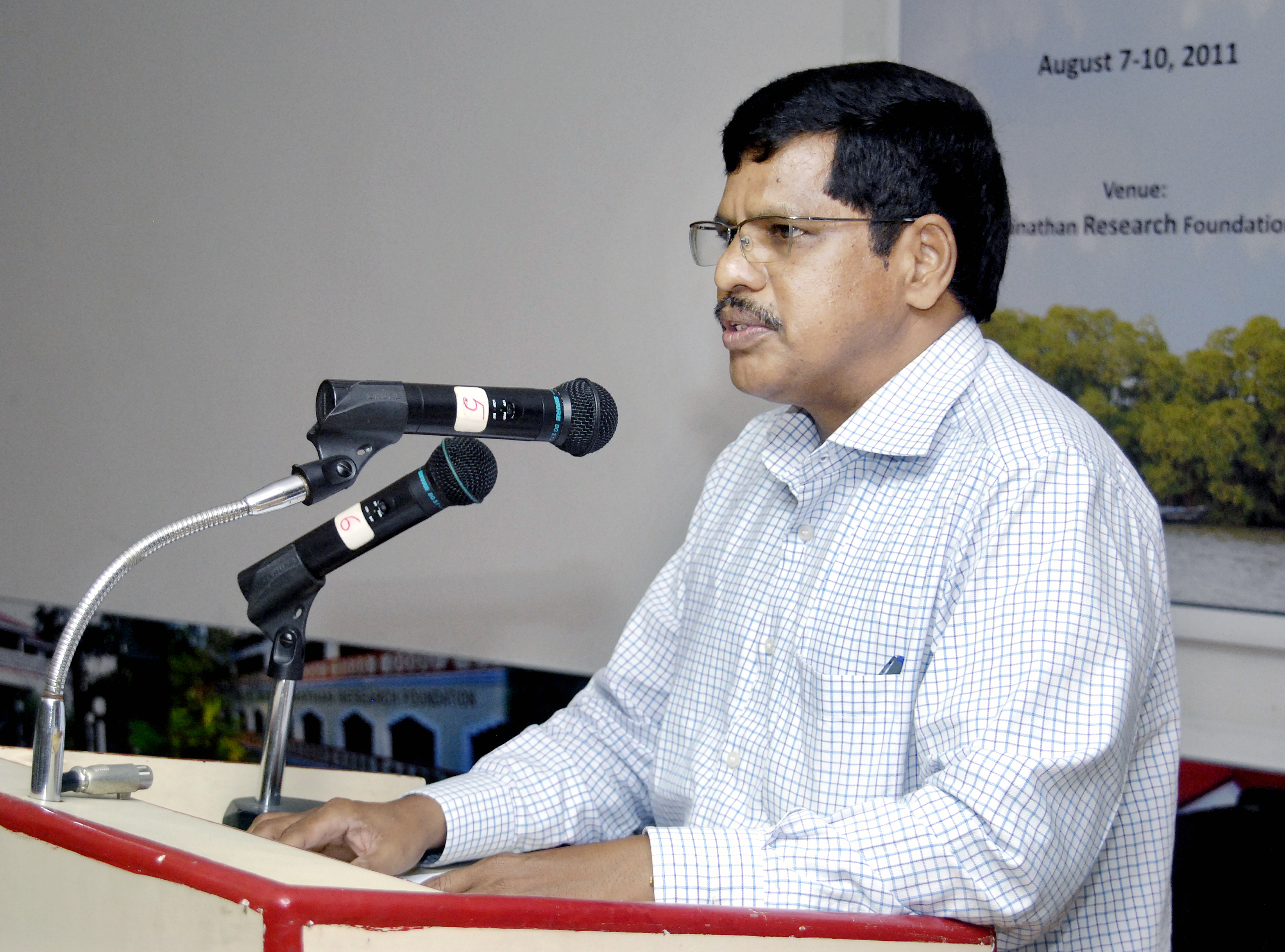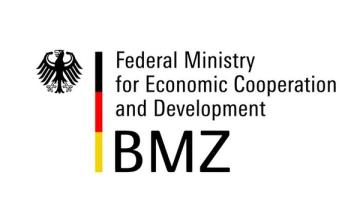Integrated Mangrove Fishery Farming System (IMFFS)
The solution provides sustainable adaptation for people depending on vulnerable coastal areas of India that are further stressed by climate change, particularly sea level rise. Socio-economic and ecological characteristics are used to plan and implement an innovative brackish water farming system. In this system, mangrove plantation is integrated with aquaculture, with mangroves and halophytes planted on outer and inner bunds (dam) of the system to protect against rising sea level, cyclones and other natural disasters and water spread area used for aquaculture for income generation.
Context
Challenges addressed
Coastal resources under stress from climate change cause challenges for people from Tamil Nadu, India, who depend on these coastal resources. These resources are at risk due to a number of climatic and non-climatic stresses, like cyclones, floods, land and groundwater salinity, water pollution, siltation of creeks in mangroves, and dwindling fish resources.
Brackish water fish farming is a key to secure income and livelihood, also under extreme climatic stress, and to reduce urban drift. But how to integrate brackish water fish farming with mangrove plantation is a challenge.
Location
Process
Summary of the process
The planning phase (building block 1) provides the baseline data to identify the major problem to be solved in order to render the target community less vulnerable, and to secure their livelihood. Village level institutions (building block 2) are crucial to engage all community members, to raise awareness of climate change related consequences, and to plan a suitable project with its individual components (micro-plans). As a result, village people constructed fishing ponds and bunds (building block 3) and equipped these with halophytes and mangroves raised in the village nursery. The participatory monitoring process (building block 4) for the implementation of the fish ponds and bunds (building block 3) improved partnership between all stakeholders, including the village level institution (building block 2) and ensured that the solution meets the expectations of all partners and beneficiaries. This process also provides feedback and complementary information to the database (building block 1). Community training is a complementary activity that helps to raise awareness and sensibility at all levels for climate change and its consequences.
Building Blocks
Situation Analysis and Vulnerability Assessment
Participatory rural appraisals help to draw a picture of both the socio-economic and environmental situation and the major concerns. Geographical assessments and the use of geographical information systems help to identify the project area and risk zones that are affected most by climate change impacts like sea level rise and salinity.
Enabling factors
Conditions for adoption elsewhere:
- Information on current and predicted mean sea levels
- Modelled impacts from sea level rise on the coastal area and community targeted
- No conflicts between hamlets in the target area
- Willingness of the community, and support for a sustained participatory process
Lesson learned
A combination of participatory and scientific tools such as GIS is very useful in bring out the real issues faced by the people.
Village Level Institutions
Gender and socially balanced village management committees are established in the target community which are governed by agreed rules. They develop regulations and micro plans for all activities and are responsible for their implementation. They try to consider the concerns and priorities of different stakeholders. Training allows them to also take into consideration new climate change findings.
Enabling factors
Conditions for adoption elsewhere:
- No existing conflicts between hamlets
- Detailed knowledge on the socio-economic composition of the community including scheduled caste and tribes
- Resources to provide the necessary training of community members
Lesson learned
Approaches taken to not only engage villagers but also to jointly establish village management committees substantially contributed to build trust, confidence and partnership between the community and the implementing organisation. The village management committee is a useful vehicle to share experiences and to spread good practices within and external to the community. It also acts as a catalyst for village people’s commitment to engage in the implementation of the project and to take responsibility for its success. Its gendered composition ensures that men and women participate in discussions and decision making. The training provided for the community and the village committee developed capacity to better understand how to adapt to deteriorating natural conditions, and to prepare for climate change consequences. The village committee acquired competence to act as advocates in other communities.
Construction of Integrated mangrove fish ponds
In the identified saline affected area, fish ponds where constructed with an innovative approach. Normally, fish ponds will have only four earthern bunds to hold water. In this model, apart from these four outer bunds, inner bunds are also created and the ponds look like a mitochandria. The inner bunds are created to provide more space for mangrove plantation. The water spread area is used for fish culture. Thus, in this system, nearly 60% to 70% is given for fish culture and nearly 40% is given for mangrove plantation. To create inner bunds a lot soil was dug from the pond and this makes the pond floor lower than the tidal level. As a result, tidal water enters the sysem during the high tide and drains out during the low tide by gravitation. Any amount of water can be kept in the system by placing tidal water inlet and outlet at appropirate hight. Due to regular tidal flushing, this systems requires no energy for pumping water in and out of the pond. Due to regular flushing by tides, no chemical treatement is necessary to maintain water quality. Since tidal water brings a lot of food, there is only a minium requirement for artificial feed. Thus, this system of fish farming is environment friendly.
Enabling factors
Successful construction and implementation depends on:
- Acceptance of communities for brackish-water adapted fish species for cultivation as traditionally bred and conceivably preferred species are no longer economically viable
- Engagement and participation of village people to construct infrastructure and to plant mangrove seedlings
- Training in aquaculture for fish farmers
- Technical and capacity development support
- Village mangrove nursery
Lesson learned
The selection of families done by the community to pilot the cultivation of brackish-water adapted fish species proofed successful as they established a model that will be replicated by other families in the community, and elsewhere.
The area selected for fish ponds and bunds should be carefully designed as to designate the major part (60-70% of the area selected) for fish, crab or shrimp farming without jeopardizing an effective regulation of the water spread by bunds (covering 30-40% of the area selected).
Fish ponds that are subject to tidal flow need to be protected against cyclones, storm surges and particularly sea water inundations that are likely to increase due to climate change induced sea level raise.
The combined systems of mangroves and halophytes proofed successful. The use of tidal flow makes redundant chemical additives and feed, thus reducing operational costs substantially.
Participatory Monitoring
A team composed of representatives from the target community, local NGOs, and local government agencies monitors the progress of project implementation and its individual activities on a regular basis. This allows to adapt plans and to modify implementation whenever required to ensure successful completion and fulfilling expectations of all stakeholders.
Enabling factors
Conditions for adoption elsewhere:
- Capacity building in participatory instruments and understanding through training
- Good relationships between cooperating partners
Lesson learned
A team composed of representatives from the target community, local NGOs, and local government agencies monitors the progress of project implementation and its individual activities on a regular basis. This allows to adapt plans and to modify implementation whenever required to ensure successful completion and fulfilling expectations of all stakeholders.
Impacts
The solution demonstrated to the community how to develop a simple, replicable, and efficient integrated aquaculture model to cope with deteriorated coastal conditions due to salinization to secure income, livelihood and to reduce vulnerability to natural disasters and climate change. The community gained skills to reproduce the solution and thus to increase the number of benefitting families. The solution transforms a saline affected area into productive sustainable aquaculture with no environmental pollution effects. Coastal protection is enhanced through mangrove and halophytes planted on bunds.
The UNFCCC has identified IMFFS as one of the adaptive strategies to Sea Level Rise and provided funds to demonstrate the same in about 50 ha in Machillipattinam in the Andhra Pradesh state of India under Adaptation Fund.
THIS SOLUTION RECEIVED EARTH CARE AWARD FOR COMMUNITY-BASED CLIMATE CHANGE MITIGATION AND ADAPTATION. This award is instituted by the Times of India (media group) and Jindal Steel Works.
Beneficiaries
Over 260 families and village communities, fish pond farmers as well as local authorities.
Story
Indrani Pakri Samy vividly remembers the days of tsunami and floods in the Cuddalore district of Tamil Nadu where she was born 29 years ago. Her family was affected by lives that were devastated and agricultural yield. Fresh water became rare with the salinisation of ground water. With a scowl, she recalls her tiresome drudgery — cutting her feet walking bare footed with her husband to collect fishes and crabs in the difficult terrain of the mangrove forest. “I remember my grandparents as rat hunters, collecting rice from rat burrows for us to eat and they ate whatever was left. After some regulation (referring to enactment of the wildlife act), they became farm labours and started carrying out fishing. Fishing was never easy for them as they had to stay in the water of the creeks for the whole day, hand picking fishes and crabs. They suffered from leg and hand wounds, skin diseases, cold and fever”. In December 2011, GIZ began working with the M.S. Swaminathan Research Foundation (MSSRF) to address the local community’s problems and to find solution. The vulnerability assessment revealed that the poor and landless local community depends on natural resources like mangroves and its fishery for their livelihood. The community became aware of facts like reduced fish catch and salinisation of ground water and other key problems like water stagnation during monsoon floods. Addressing the challenges identified, a science based, community centred and process oriented scheme termed ‘Integrated mangrove fishery farming system (IMFFS)’ was developed and implemented. This system now provides both, physical protection against sea level rise, floods and cyclones, and livelihood security to the vulnerable coastal community in Cuddalore district. The raised bunds of this farming system act as saline embankment guarding coastal villages from salt water intrusion during storm surges. At the same time the system enables the community to continue generating income from fish cultures by using salt tolerant fish species. What changes brought the solution to Indra’s life? With a wide smile she added, “Now we have three meals a day and we also enjoy vegetables and fruit on each Sunday, which was not the case before the project. I could also buy a silver anklet for my daughter”.





